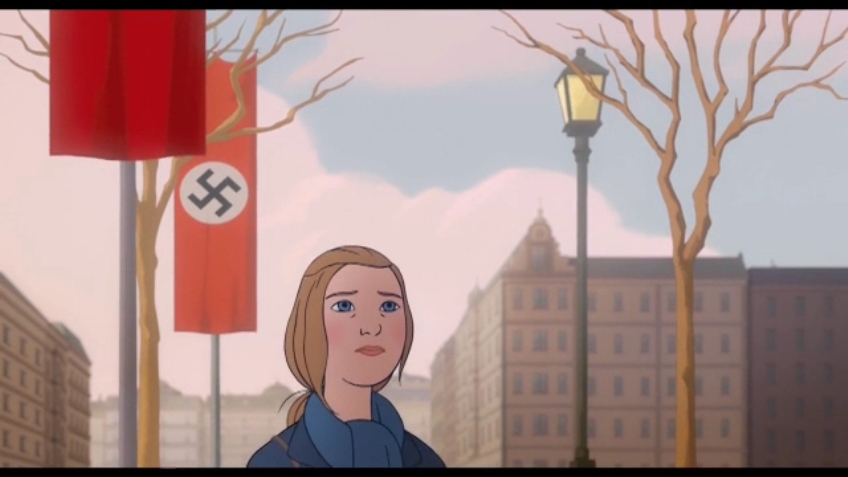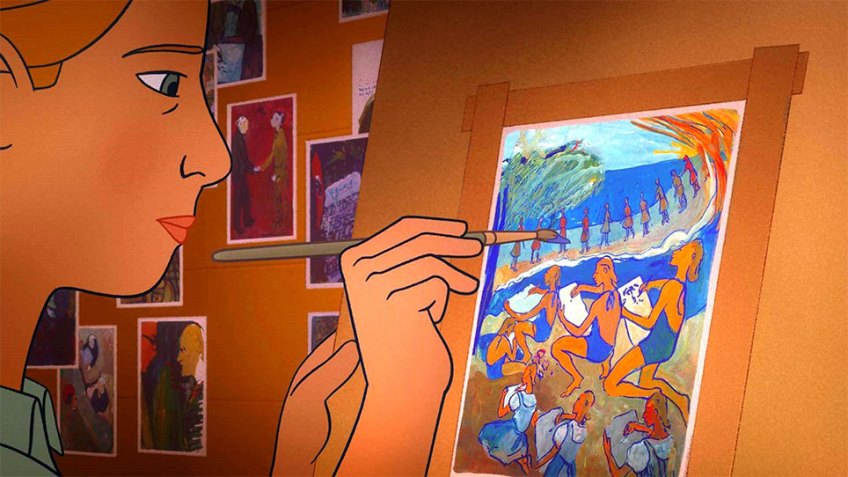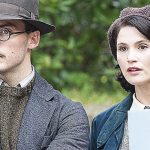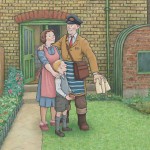Joyce Glaser reviews Charlotte (November 18, 2022) Cert 12A, 92 mins
Animation is not always furry animals and children’s matinees. In the right hands it can be the most powerful way to reconstruct inchoate, traumatic memories of a dubious war, as in Waltz with Bashir, or form a protective shield for the gay Danish academic in Flee, who, as a boy fled Afghanistan with false documents. Directors Eric Warin and Tahir Rana use painterly 2D animation in strategically arranged colours and tones to tell the moving, powerful story of the eponymous German-Jewish artist Charlotte Salomon. Form and content complement one another as some 80 years ago Charlotte told her own autobiographical story through a series of nearly 800 gouache pictures entitled Leben? oder Theater?: Ein Singspiel (Life? or Theatre?: A Song-play).
Despite previous films, a documentary, a play and even an opera about Solomon, her story – and her art – remain largely unknown. Charlotte – with a stellar voice cast led by Keira Knightley and Jim Broadbent as her tyrannical, abusive grandfather, might well change that.
Charlotte Salomon was born in wartime Berlin in 1917, where her father, Albert (Eddie Marsan), was a respected, prosperous surgeon. When Charlotte was only 8, her sensitive mother Franziska (Grünwald), committed suicide, although to shield her, Charlotte was told it was influenza. Albert remarries Paula Salomon-Lindberg (Helen McCrory in her final role), an opera singer.

It is 1936 and Charlotte has been studying fashion design, intimated by the rise of the National Socialist German Workers’ Party. We see her attend an interview to secure a place at the Academy of Fine Arts, where one of the panel members points out “the unfortunate matter of your race.” But the committee is swayed by the quality of her sketches and her grandfather’s Iron Cross. She enjoys a successful two years there before being expelled in 1938 by the Nazis.
During these fraught years when the Nazis were increasing their antiSemitic policies, Charlotte meets two people who will become major influences on her art and life While copying masters in the art museum, Charlotte meets a wealthy German-born American, Ottile Moore (Sophie Okonedo) who admires her work. Aged 19, Charlotte becomes romantically involved with her stepmother Paula’s voice coach, Alfred Wolfsohn (Mark Strong). He takes her art seriously and asks her to illustrate the memoirs of his traumatic experience in the trenches in the first World War.
As the dark colours of the animation intensifies, the directors choose Kristallnacht for the night when the lovers meet in a bar for Charlotte to deliver her expressive illustrations to Alfred. It is that night, as Nazi thugs attack the restaurant, beat up Alfred and throw his book in the fires, that she learns he has been lying to her.
With her grandparents already in the Côte d’Azur Charlotte’s father, who, after a brief internment flees with Paula to Amsterdam, sends her there. The animation changes and we get soft, pastel colours. At Ottile’s idyllic oasis of calm she meets another Jewish refugee, Austrian groundskeeper Alexander Nagler (Sam Claflin). Charlotte paints and becomes Nagler’s lover. In 1943 they will marry, with Alexander admitting his Jewish heritage in order to get a judge to sign the papers.

At the outbreak of war Charlotte’s grandmother (Brenda Blethyn) suffers psychotic episodes and Ottile brings in a kindly doctor, Dr Moridius (Henry Czerny) to help. It is in vain and when the Nazi’s invade France and the grandmother is denied access to painkillers, she makes several attempts at suicide before jumping from their window.
Ottile offers to take Charlotte and Alexander with her and the other Jewish children she is harbouring to Portugal and then on to America. Charlotte declines because of her family, although it is a disastrous decision.
Charlotte spends the worst months of her life taking care of her increasingly cruel and sadistic grandfather who enjoys telling the vulnerable Charlotte that, in addition to her mother, Charlotte’s aunt Charlotte committed suicide, as did her great-grandmother, her nephew and a great uncle. He suggests Charlotte will follow them.
Her residence permit requires Charlotte to live with her grandfather who, whether suffering from Alzheimer’s or psychosis has become a monster. As her world closes in on her Charlotte, makes a startling yet cathartic decision. After her decisive act, she and Alexander make plans for the birth of their child in a climate of doom.
In 1942, before moving to Nice to care for her grandfather, Charlotte, on the verge of mental collapse and exhaustion, rents a room in Saint-Jean-Cap-Ferrat and embarks on an intensive year of painting. She tells Alexander, ‘only by doing something mad can I hope to stay sane.’ But age 26, she knows that time is running out.
Charlotte begins to paint, in gouache, her life’s story. It is frequently subjective as the series expresses her feelings and emotions as well as the facts. All the locations and characters are there chief among them, the duplicitous love of her life, Alfred. Warin and Rana spend ample time showing us these remarkable illustrations many in German expressionist style and colours reminiscent of Chagall.
But Life? or Theatre? is also one of the earliest graphic novels as Charlotte includes approximately two hundred transparencies with text to be overlaid on their associated gouaches. The only way to fully appreciate this book and understand the symbolism is to go to the Jewish Historical Museum in Amsterdam.
In a flashback at the opening of the film and again at the end when we understand the context, we see Charlotte entrust her autobiography to Dr Moridius. ‘Keep this safe, it is my whole life,’ she prophetically tells him. An intelligent touch, the directors end the film with a moving coda. Albert and Paula, who survived the war, are interviewed about their daughter and the book they received from Dr Moridius in 1947.




